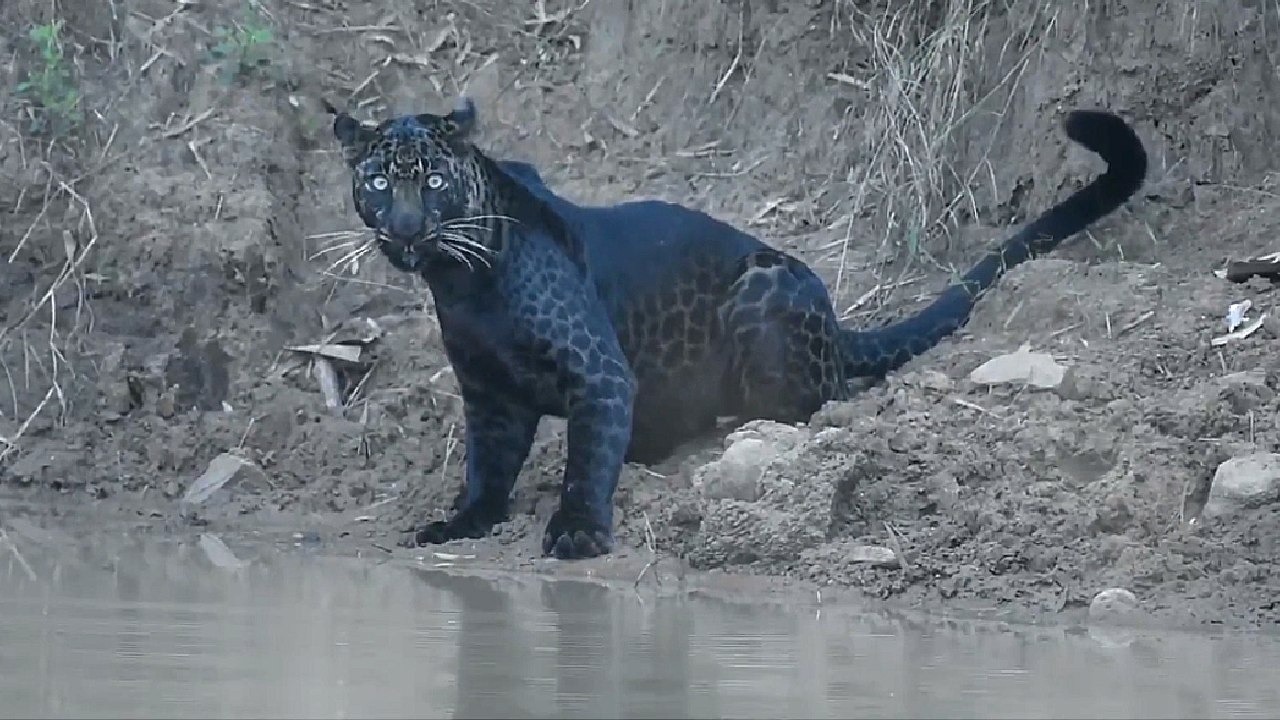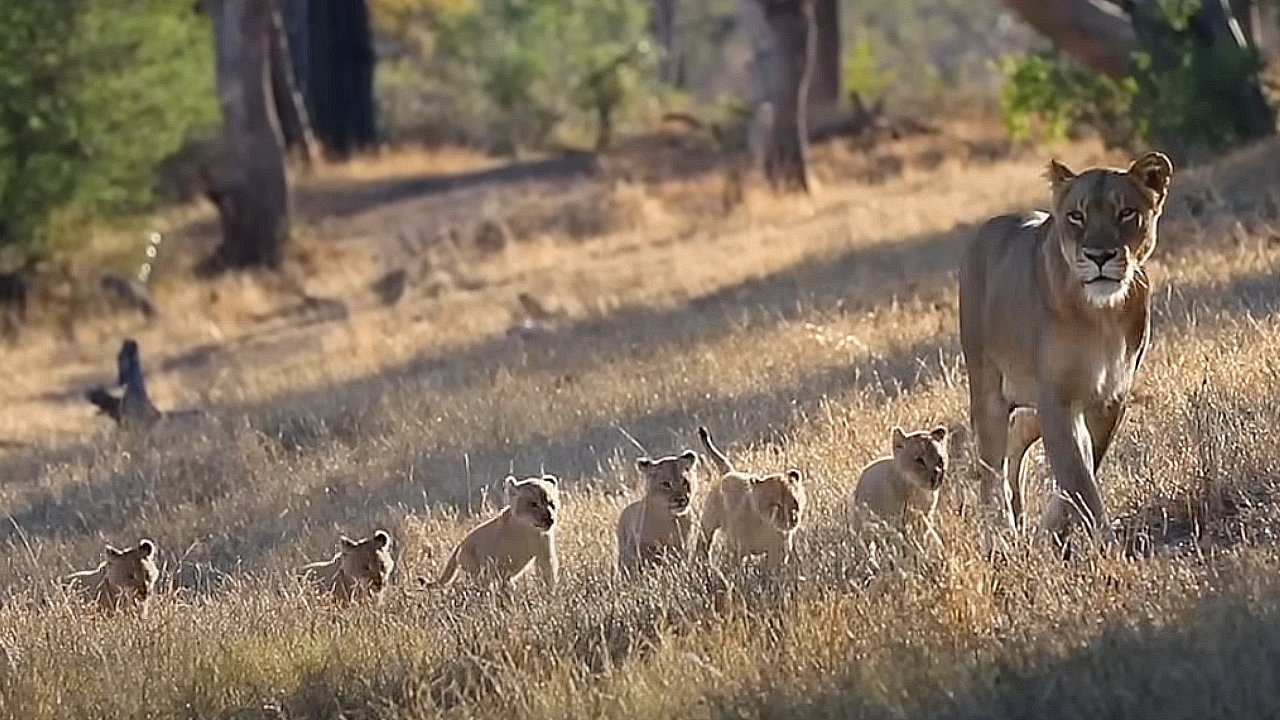A fisherman known as Western Australia’s ‘shark man’ has captured an incredible photograph showing himself and a friend wrestling a huge tiger shark off the Carnarvon Beach on the north coast.
Josh Butterworth and Jethro Bonnitcha, both 29, were caught on camera as they struggle to pull the giant shark on to the beach.
Mr Butterworth posted a photo of the massive shark on his Instagram with the caption ‘every one of us has the same look on our faces…a mix of confusion and I wish he would play nice’.
The fisherman spoke to Daily Mail Australia about the catch and admitted it was tough and the shark had a ‘lot of fight’.
Scroll down for video
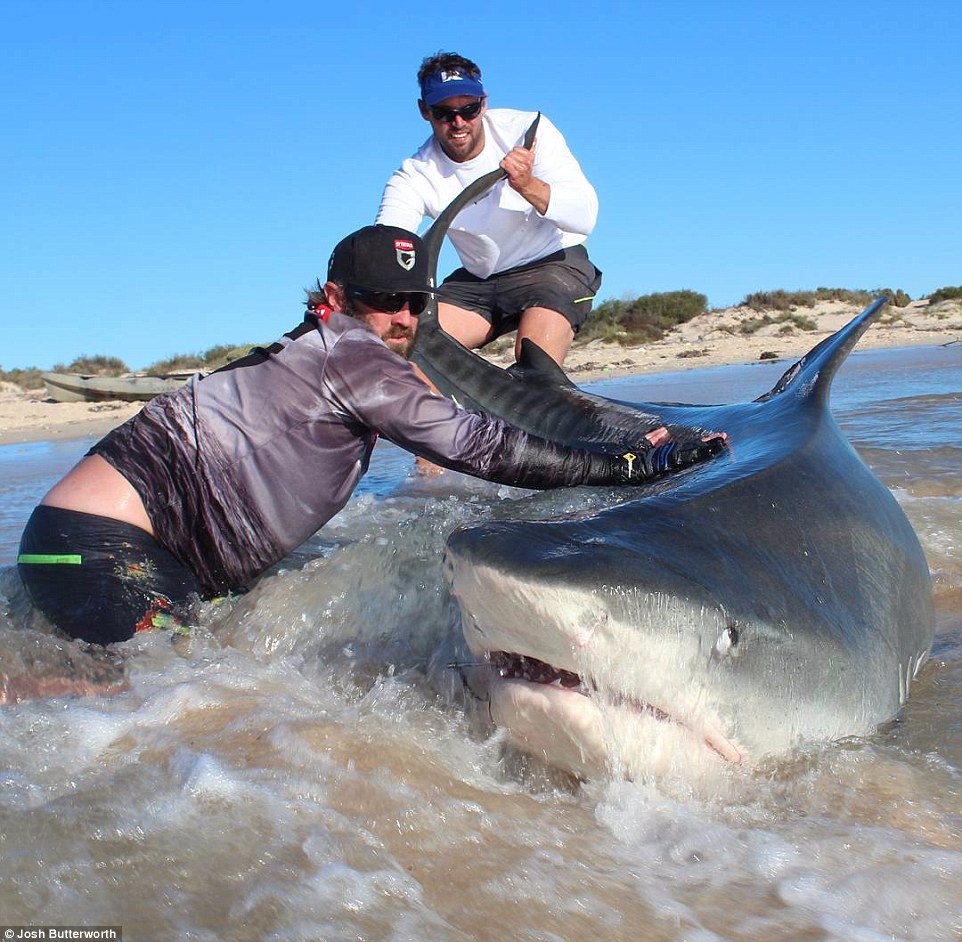
Josh Butterworth posted a photo of the massive shark on his Instagram with the caption ‘every one of us has the same look on our faces…a mix of confusion and I wish he would play nice’
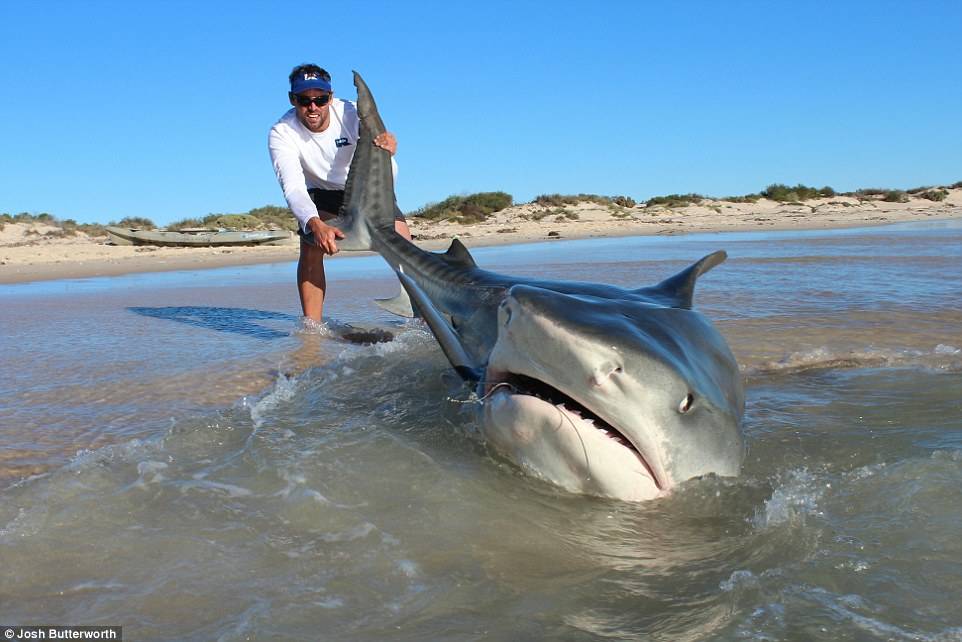
Jethro Bonnitcha holds a large tiger shark’s tail as it thrashes around in the water after he and his fishing partner Josh Butterworth landed ten sharks on a four-day fishing trip on the West Australian north coast
The two fishermen reeled in ten massive tiger sharks from the beach on a four-day fishing trip in June as ‘plenty more’ lurked in the water only meters from shore.
The anglers used kayaks to set the baited lines around 100 metres from the shore and reeled in the marine predators – some of which were over five metres long – from the sand.
‘We landed ten and lost a fair few but we saw a lot more swimming in the water that we didn’t catch,’ Mr Butterworth told Daily Mail Australia.
‘There is no shortage of sharks up there,’ he added.
Mr Butterworth said they caught two simultaneously and almost had three on the go when another shark took the bait as they both had their hands full reeling in another catch.
‘We both had a shark, Jethro got his up on to the shore and a third was going at the bait,’ he said on Wednesday.
The men used stingrays, fish bones and heads as bait to lure the animals closer to shore and had to paddle back out into the shark infested waters once it has been taken.
‘When they take the bait, or take a bit and spat it out you have to paddle back out and reset it. I don’t like that bit because you know there are some just there in the water,’ Mr Butterworth said.
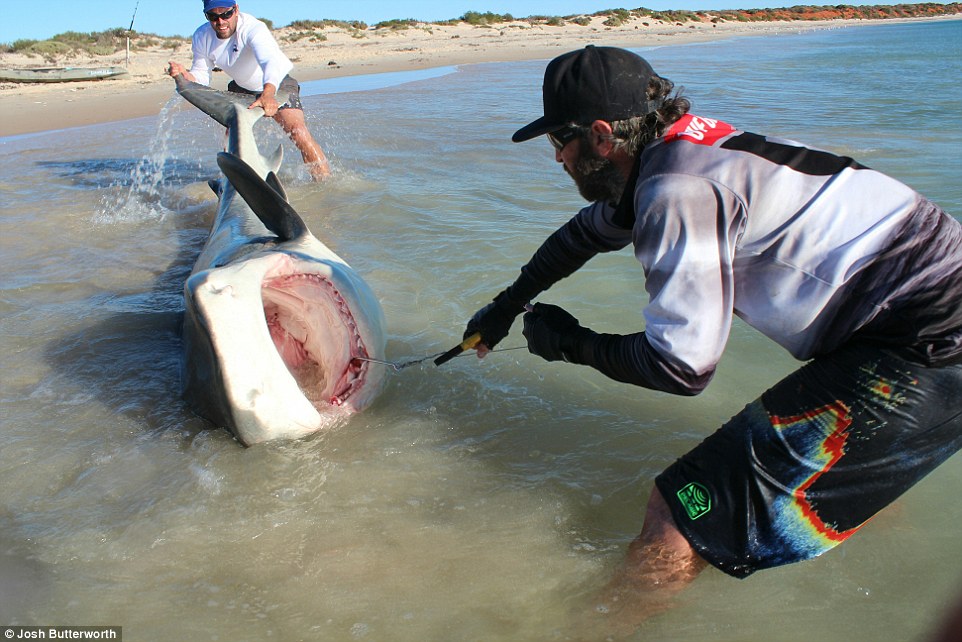
The anglers don’t use any mechanical equipment to haul the massive predators to shore once they see them thrashing near the bait, relying only on drag and brute strength to land the catch
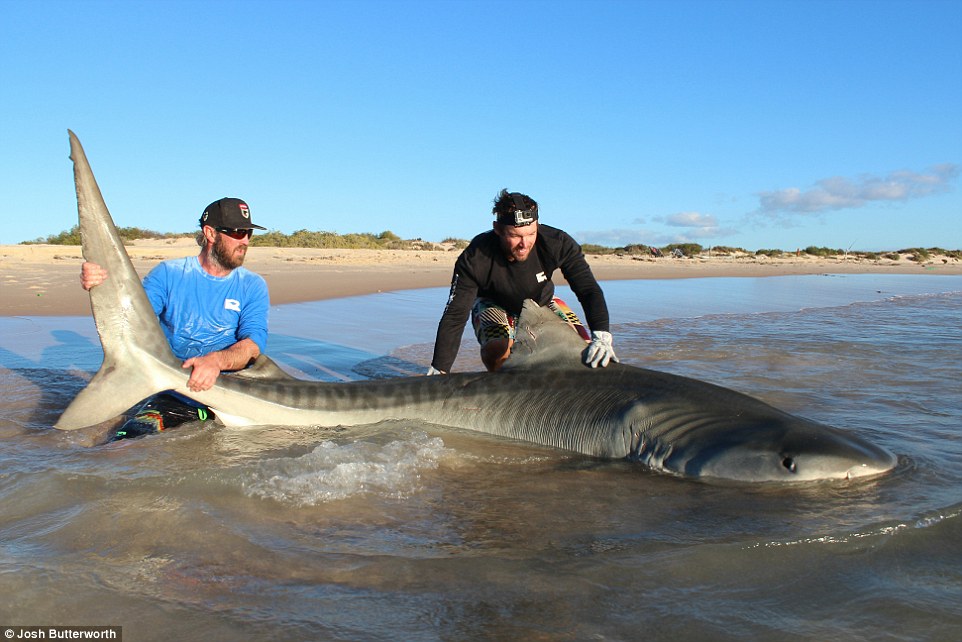
The fisherman said tiger sharks aren’t as dangerous as pointers and noted that they are very inquisitive and will swim up to ‘say hello’
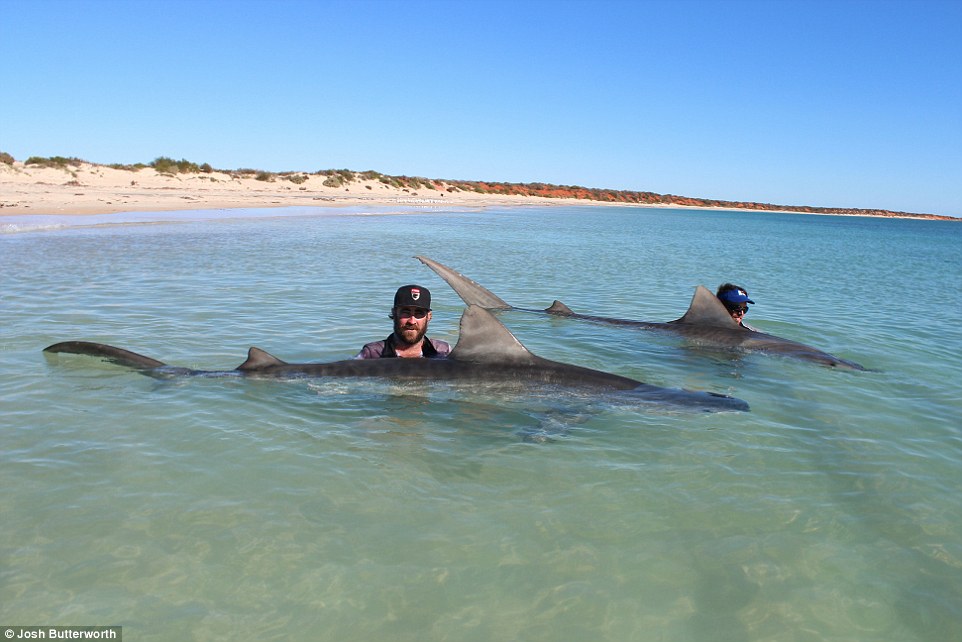
Mr Butterworth (left) said they caught two simultaneously and almost had three on the go when another shark took the bait as they both had their hands full reeling in another catch
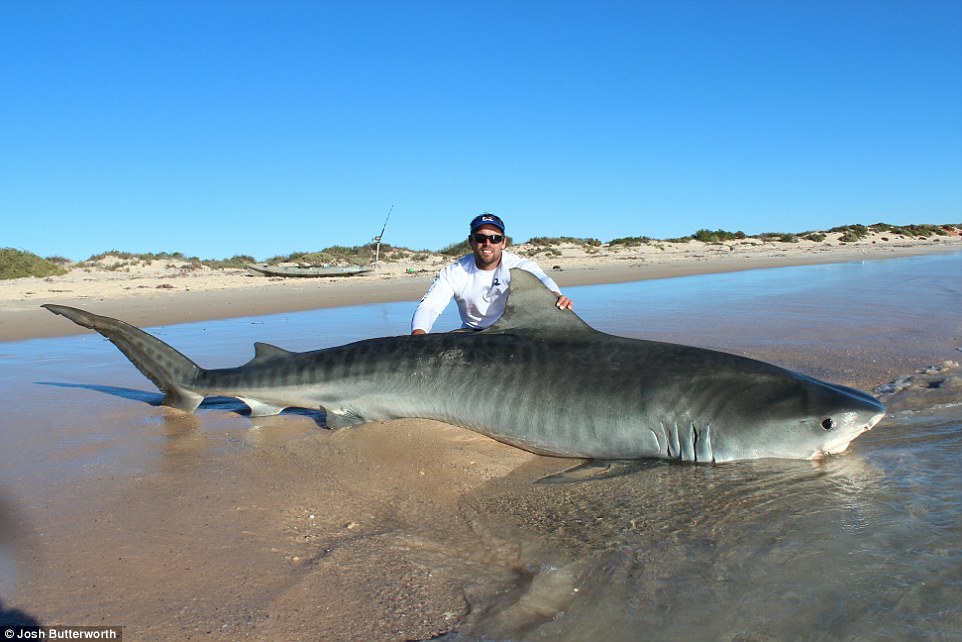
Mr Butterworth captured images of the large sharks on the sand before he and his fishing companion (pictured) released them back into the water
The anglers don’t use any mechanical equipment to haul the massive predators to shore once they see them thrashing near the bait, relying only on drag and brute strength to land the catch.
‘Once they come along you have to go like b**gery to pull them in.You just have commit your body to it then when you get them onto the beach someone has to run in the water to grab him by the tail’,’ he told Daily Mail Australia.
Mr Butterworth, who has been fishing since he was a child, said he is no longer apprehensive about getting in the water with tiger sharks in the shallows and likened them to ‘puppy dogs’ in the water.
‘When you have them in the water holding them they’re like big puppy dogs. As soon as you take your hands off them they bolt – they are pretty lazy things.’
‘Tiger sharks aren’t the worst. They come up and say hello but aren’t that dangerous. You just don’t want to see a pointer like down south,’ he added.
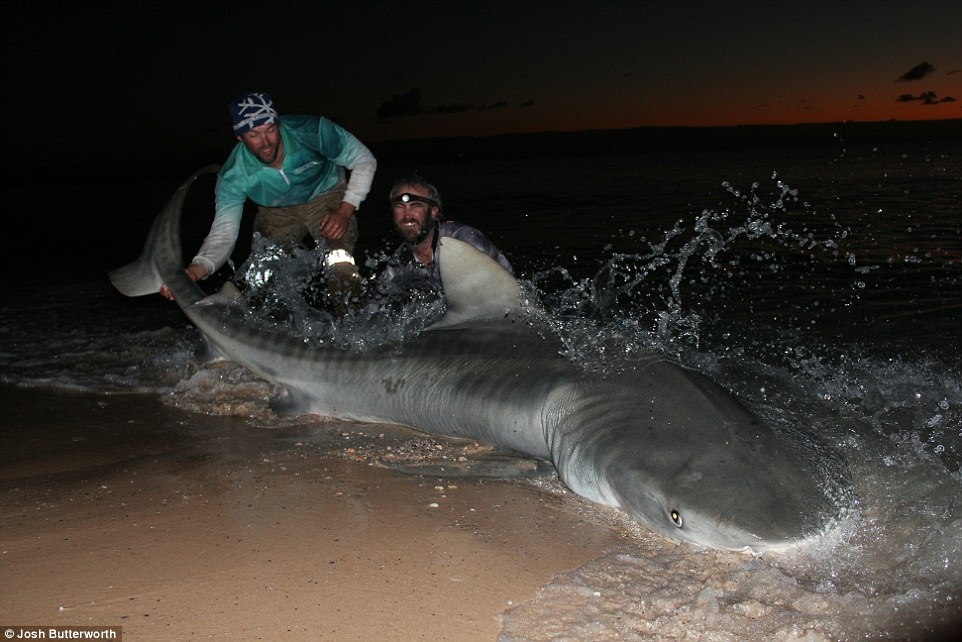
The experiences fisherman said he would enter the water after reeling a shark to shore, but he argued it was a different story when going for a swim or when paddling the bait out
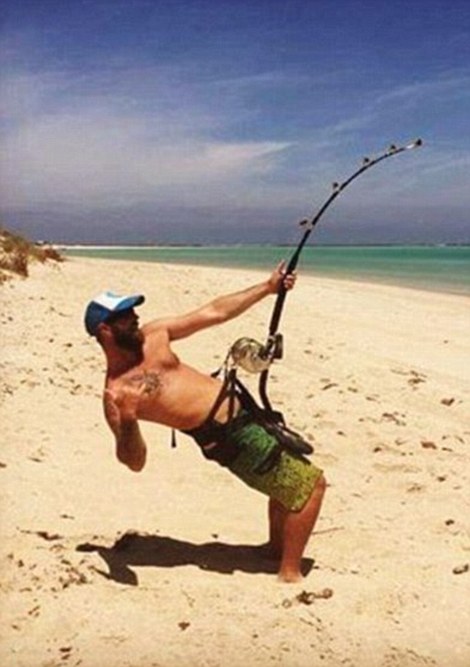
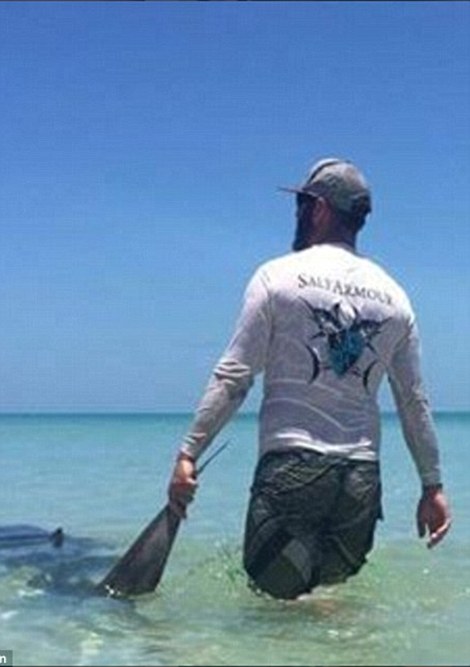
The men use hand held rods with a harness (left) and guide the sharks back into the water (right) after taking a couple of photographs
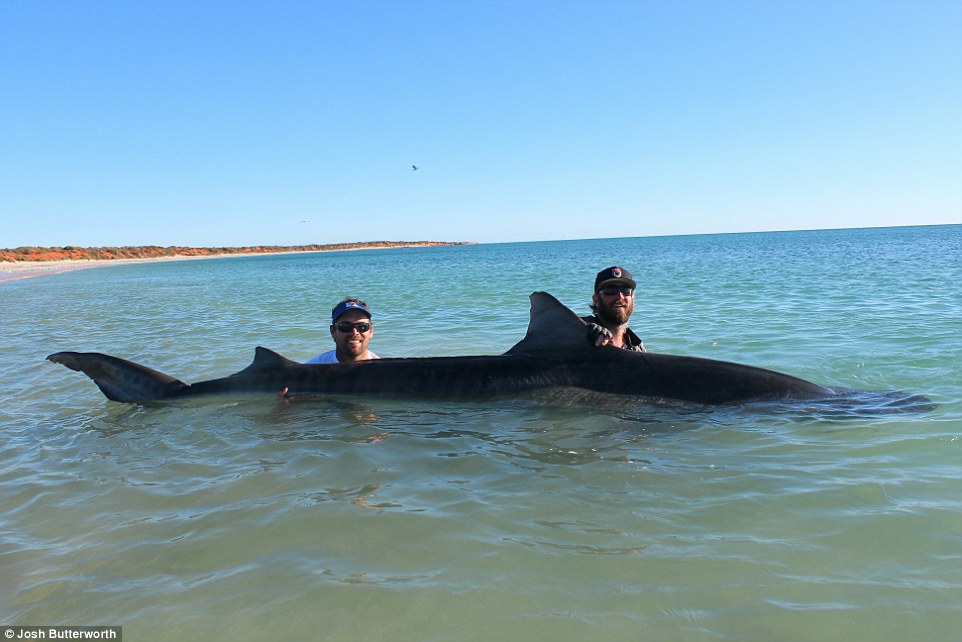
Mr Butterworth, who has been fishing since he was a child, said he is no longer apprehensive about getting in the water with sharks in the shallows and likened them to ‘puppy dogs’ in the water
WHAT ARE TIGER SHARKS?
Tiger sharks are the fourth largest shark in the world and are usually found in warm, tropical or sub-tropical waters. They are solitary sharks and known to be aggressive, with the number of attacks on humans coming second only to the great white.
They are named after the dark, vertical stripes found on their bodies, which often start to fade as they reach maturity. They have blunt noses and their dorsal fins are positioned close to their tails.
Tiger sharks have an excellent sense of smell and sight making it easy for them to hunt at night. They are not known to be picky eaters and have will target other sharks as well as fish, birds, seals, stingrays and sea snakes.
They can grow up to seven and a half metres long but on average measure in at about 3 and a half metres. Tigers can weigh between 385-635 kilograms and live for up to 50 years.
Source: National Geographic
The experienced fisherman said he is willing enter the water after reeling a shark to shore, but argued it was a different story when going for a swim or when paddling the bait out.
‘Jethro had a 12 footer and a nine footer come up to him on the kayak and eyeball him when he was paddling out the bait.’
‘He threw it in the water and paddled back pretty quickly but they didn’t seem too interested in the bait and just kept having a look at him.’
Mr Butterworth captured images of the large sharks thrashing around in the shallows before he and his fishing companion released them back into the water.
‘We don’t need to kill them. We do a lot of game fishing and when it’s not marlin season we just try to find something that pulls as hard as they do.’
He said the murky waters around Carnarvon are known to harbour bull sharks but his main concern was great white sharks, also known as white pointers, which are believed to be responsible for two deaths near Perth in the last three weeks.
‘There are no shortage of pointers off the south coast. Down there I won’t paddle out in a kayak at night,’ Mr Butterworth said.
Doreen Collyer, 60, was diving at a reef off Mindarie Beach, about 35 kilometres north of Perth, when she was attacked by a shark on June 5.
The grandmother was pulled from the water and put on a fishing boat but died before she got to shore.
Ms Collyer’s death came just days after surfer Ben Gerring had his leg bitten off by a white shark while paddling his surfboard at Falcon Beach in Mandurah, south of Perth, on June 1.
The 29-year-old father-to-be was brought to shore by fellow surfers and taken to Royal Perth Hospital, but died late on Friday night from his injuries.
Mr Butterworth and Mr Bonnitcha have posed alongside an array of catches over the years and gained notoriety after landing a large hammerhead and tiger shark in January. Mr Bonnichta caught the hammerhead in about an hour and a half, and the tiger shark took between 30-40 minutes.
He estimated they weighed between 350-400 kilograms and required fishing gear with a 60 kilogram weight rating. The sharks were only two of more than 30 caught from the beach during a week long fishing trip.

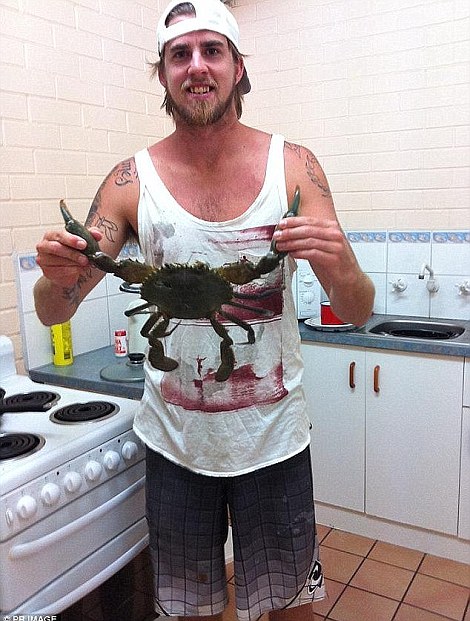
Diver Doreen Collyer (left) died after a shark attacked her at a reef off Mindarie Beach while surfer Ben Gerring (right) had his leg bitten off by a white shark only days later while paddling his surfboard at Falcon Beach and died two days later
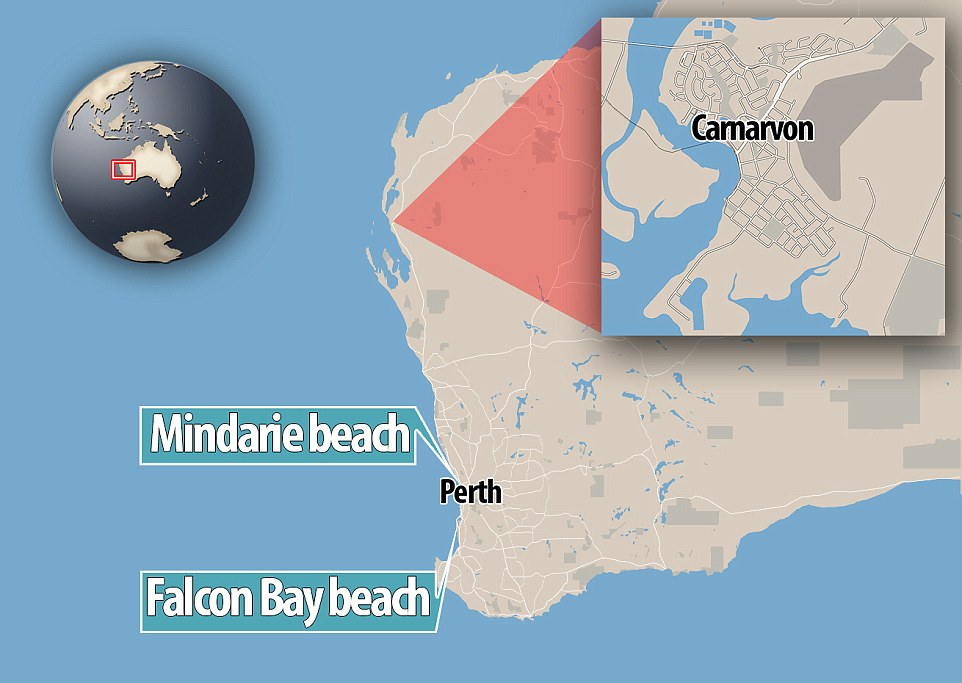
The two fatal attacks took place near Perth, while the ten tiger sharks were landed further north at Carnarvon beach
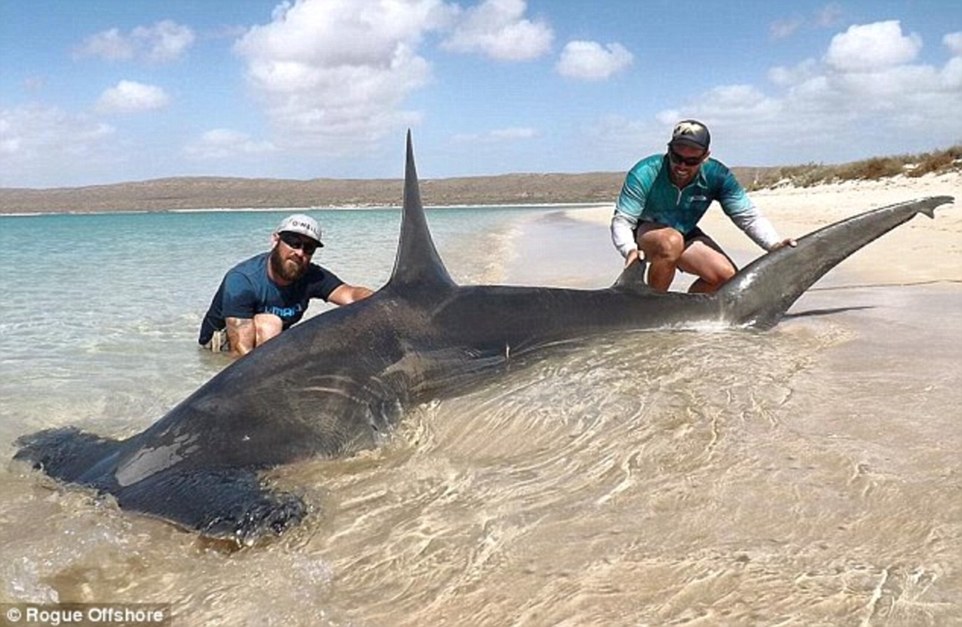
Mr Butterworth and Mr Bonnitcha managed to land a large hammerhead and tiger shark in January
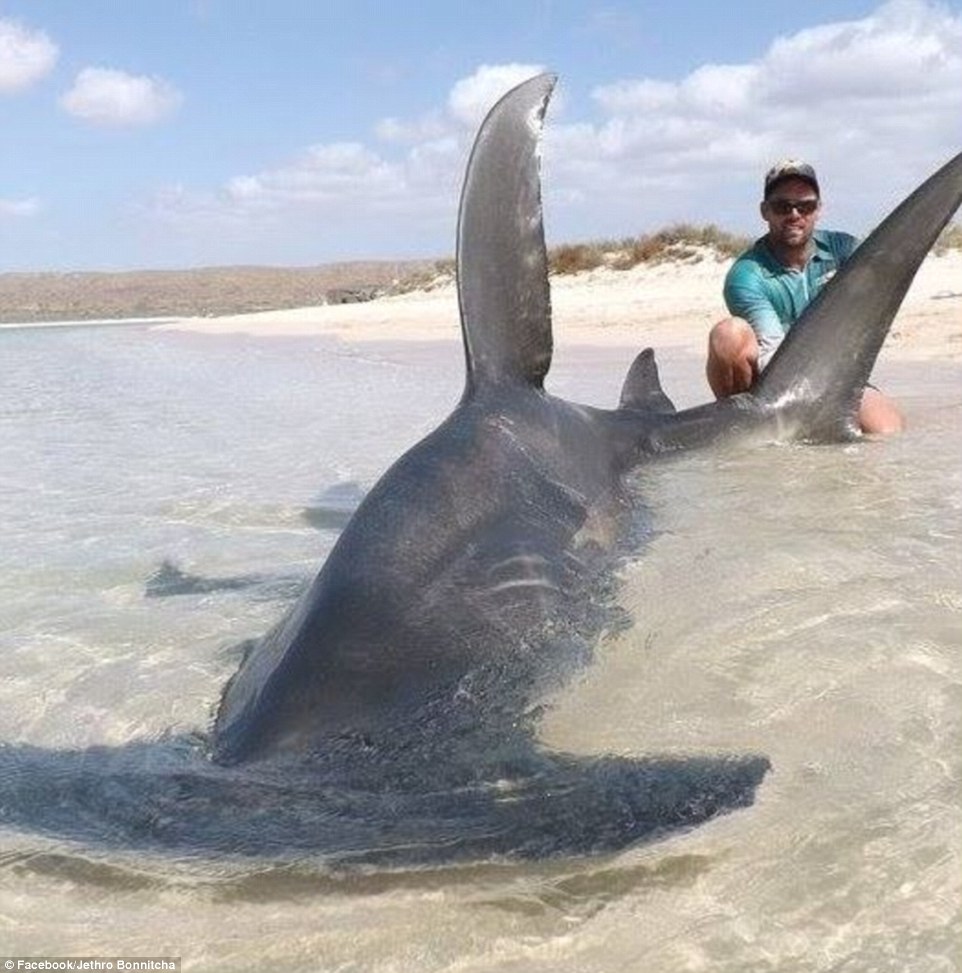
Mr Bonnichta (pictured) caught the hammerhead in about an hour and a half, and the tiger shark took between 30-40 minutes
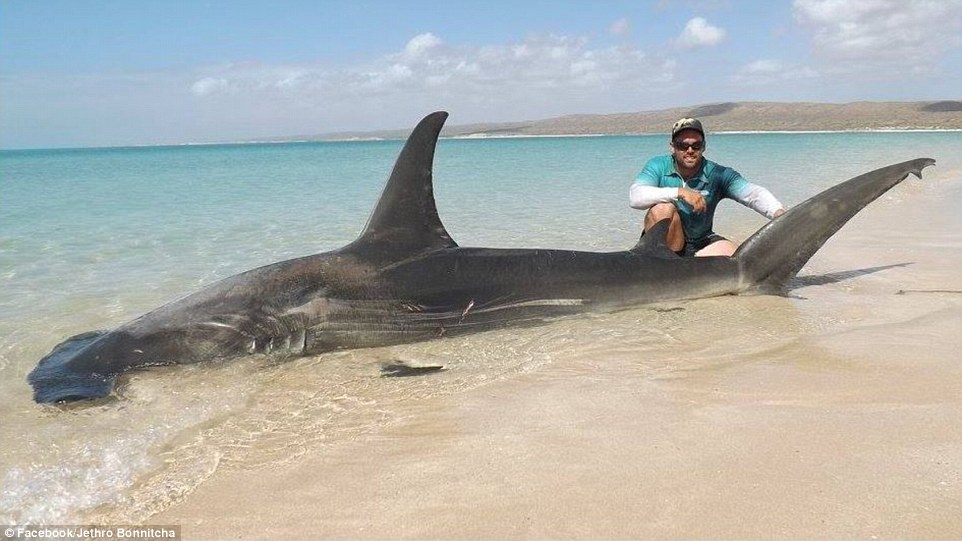
The sharks were only two of more than 30 they caught from the beach during a week long fishing trip.


